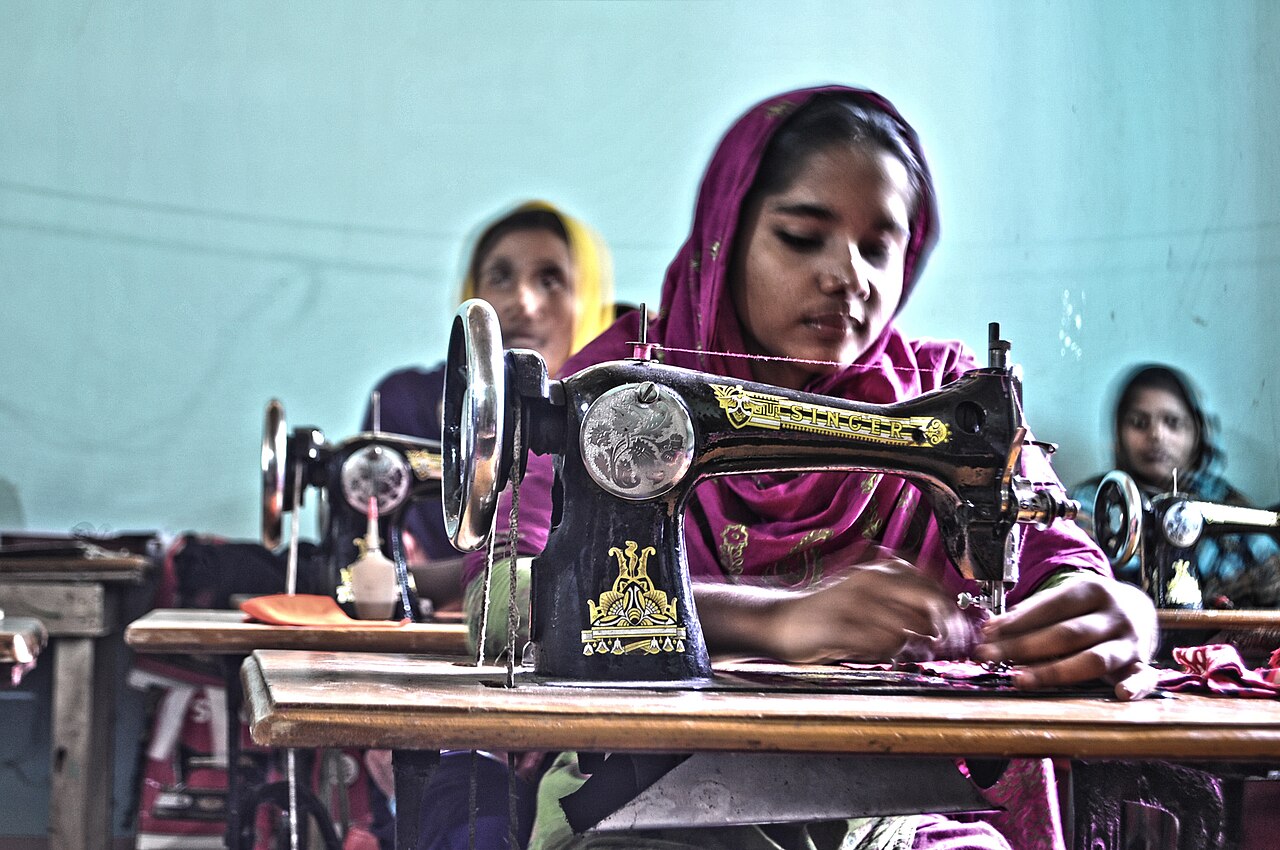When I get up in the morning, put on my shoes and tie up the laces, I often ask myself: “who made those shoes?” Likewise, when I sit at the table to have breakfast, I wonder, “who made the table and who worked on the farm that produced the oats in my porridge?” When I go for my annual check-up at my local doctor’s surgery, I wonder: “to what class does the nurse belong?” You may be wondering why I ask myself these questions. Well, it is because we are bombarded by the idea, apparently in defiance of my experience, that the working class no longer exists; that it has been dissolved and now we are all mostly ‘middle class’.
Especially in the wake of the collapse of the Soviet Union in the 1990s, it became fashionable to promote the idea that class struggle was a thing of the past, and even that the working class no longer existed. Many writers have continued to churn out articles, books, research papers and so on, that argue that the working class has either been massively reduced in its weight in society, becoming an irrelevant force, or even ceased to exist altogether.
A barrage of propaganda has emanated from the academic world. An example of this was a text published in 1996 by postmodernist writers Jan Pakulski and Malcolm Waters, The Death of Class, in which they argued that class is a purely historical phenomenon, and that a class perspective today has become an impediment to understanding contemporary society. They state, “…that classes are dissolving and that the most advanced societies are no longer class societies.”
It was not solely the collapse of the Soviet Union that impacted on such so-called ‘intellectuals’. The 1970s had seen a widespread movement of the working class across the globe. The May 1968 movement in France, the Hot Autumn in 1969 in Italy, and the huge upsurge in strikes and revolutionary movements across the capitalist world had begun to ebb by the end of the 1970s, and in the 1980s there was a sharp decline in strikes everywhere.
Major strike movements were defeated due to the lack of fighting leadership. In Britain the 1984-85 miners’ strike was a key turning point: an almighty battle on the part of the miners – with insurrectionary connotations at times – went down to defeat. Similar battles were lost in Italy (FIAT in 1980), the United States (Reagan’s strike-breaking measures against PATCO, the air traffic controllers in 1981), and in many other countries.
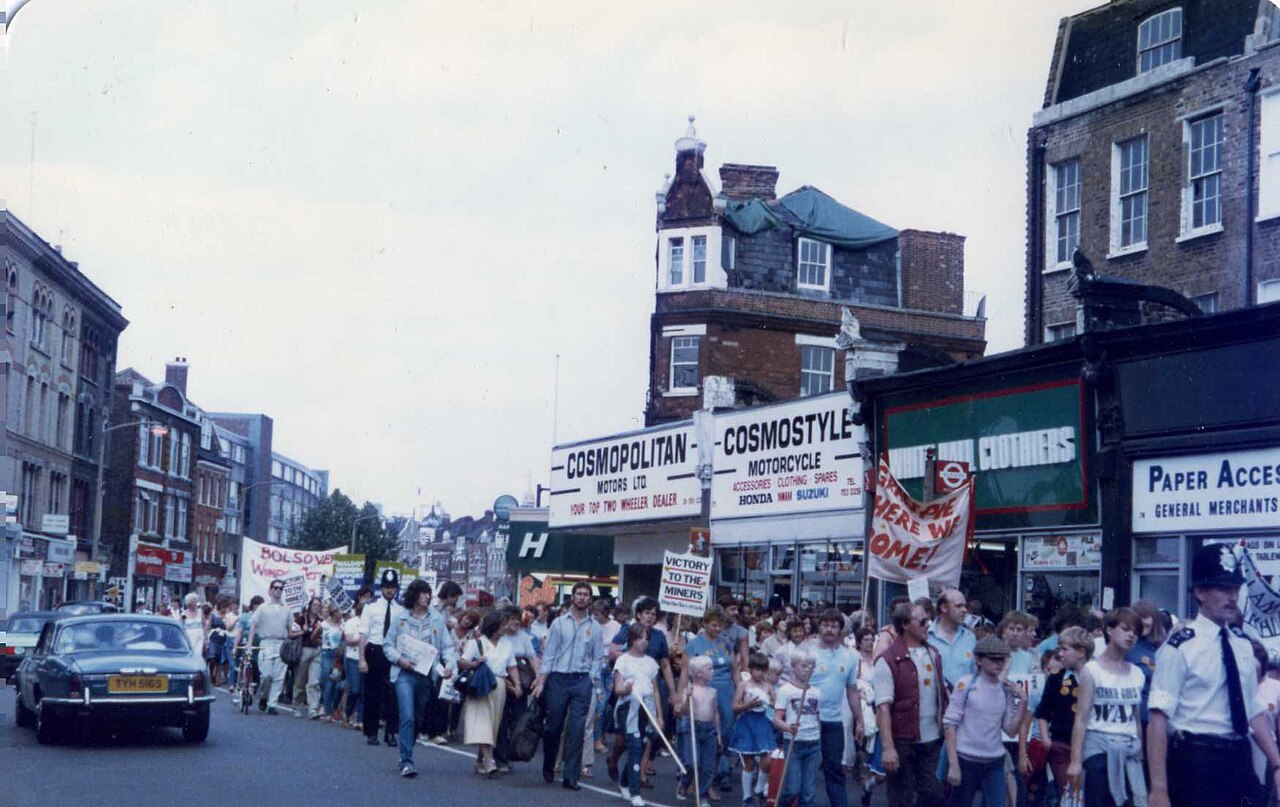 In Britain the 1984-85 miners’ strike was a key turning point / Image: sludgegulper, Wikimedia Commons
In Britain the 1984-85 miners’ strike was a key turning point / Image: sludgegulper, Wikimedia Commons
This led to a lull in the class struggle, falling trade union membership in many countries, and a loss of confidence in the reformist and Stalinist parties that had been responsible for the defeats of the working class. This in turn had an effect on many academics who had previously leaned to the left. Pakulski and Waters reflected this when they wrote:
“With the declining commitment to Marxism, the collapse of Soviet communism and the waning appeal of socialist ideologies in the West, class is losing its ideological significance and its political centrality. Both the right and the left are abandoning their preoccupation with class issues. The right is turning its attention to morality and ethnicity while the critical left is becoming increasingly concerned about issues of gender, ecology, citizenship and human rights. […] Class divisions are losing their self-evident and pervasive character. […] Class radicalism is no longer the flavour of the month in the intellectual salons and on university campuses. Like beads and Che Guevara berets, class is passé, especially among advocates of the postmodernist avant-garde and practitioners of the new gender-, eco- and ethno-centred politics.”
The traditional mass parties of the working class, such as the Labour Party in Britain, were also affected by all this. Huge numbers left these organisations, while at the same time the right wing consolidated its grip. The rise of Blairism was a consequence of all this. And in line with the thinking of the likes of Pakulski and Waters, John Prescott, former deputy prime minister under Blair, stated before the 1997 general election that, “we are all middle class now.” Meanwhile, Tony Blair famously declared in his speech to the Labour Party conference in 1999 that, “The class war is over.”
Not all academics, however, argue that class has lost its meaning. The academics Geoffrey Evans and James Tilley, for instance, have argued that reports of the ‘death of class’ in Britain are premature. Of the tendency to write off the working class, they wrote:
“The rise of the middle class has often been seen as indicating the end of both class division and of the political importance of class. Shrinking divisions between social classes are seen as a natural consequence of deindustrialization, increased affluence, greater welfare provision and the breakdown of traditional class communities. At the extreme, it is claimed that ‘the dynamism of the labour market backed up by the welfare state has dissolved the social classes’ (Beck and Beck-Gernsheim 2002, p.203). We are thus left with an amorphous social structure devoid of class difference: a society in which everyone is middle class or has no class at all.” (Geoffrey Evans and James Tilley, The New Politics of Class: The Political Exclusion of the British Working Class, OUP Oxford, 2017)
However, even Evans and Tilley, in defending the idea that the working class does exist, point to the reduction in its size and the growth of the so-called middle class. But they can only do this by placing in the middle class, categories that clearly engage in wage labour, and therefore belong to the working class from a Marxist point of view.
What does it mean to be working class?
A lot of the confusion stems from what one defines as being ‘working class’. In the academic world, many look at levels of education or income to determine one’s class. But this ignores the real essence of what it means to be working class. It is not about what kind of music you listen to, or whether you read this or that kind of novel, or whether you have high or low wages. To be working class, or proletarian, means that in order to make a living you have to sell your ability to work to someone else.
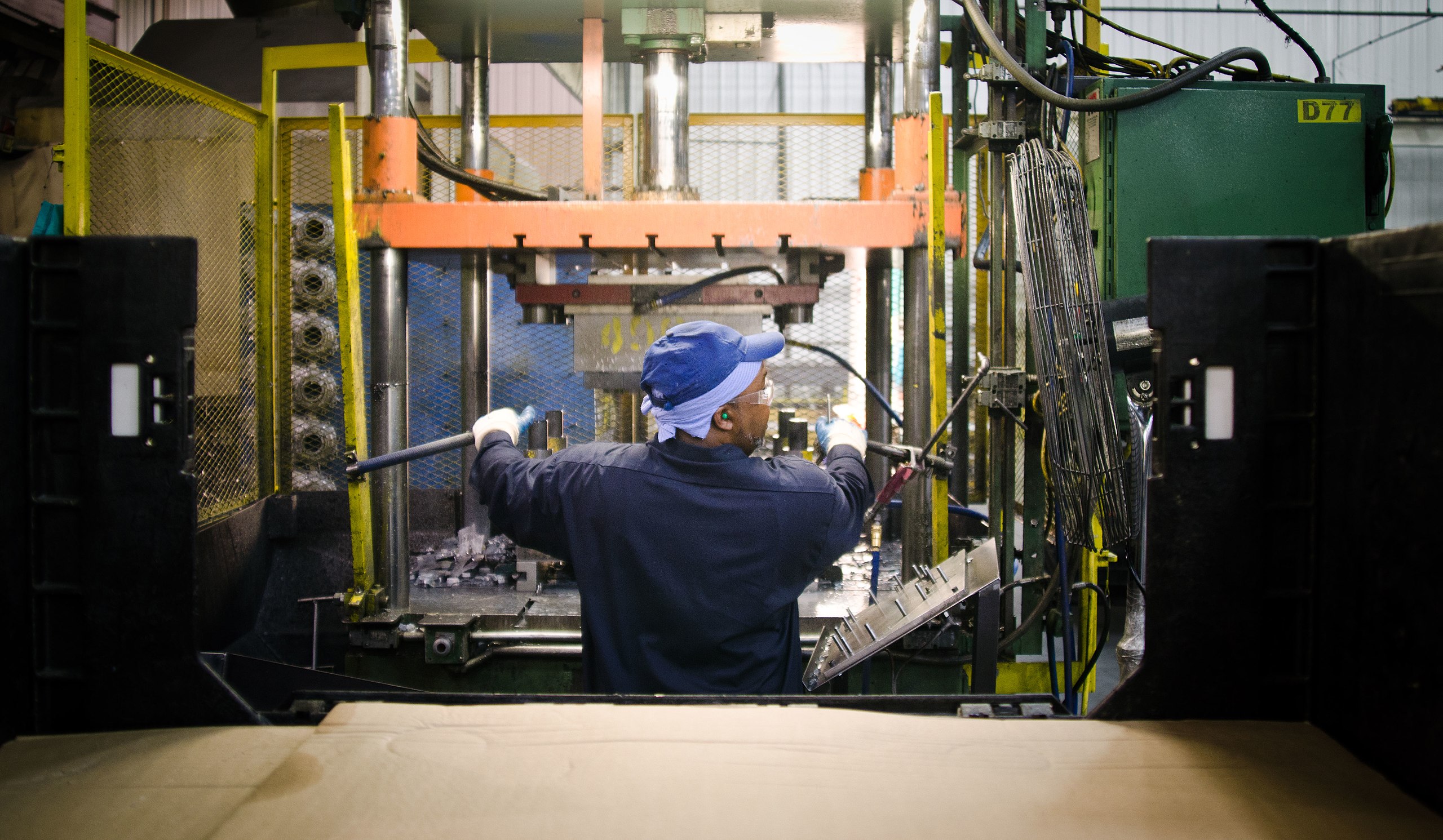 A lot of the confusion stems from what one defines as being ‘working class’ / Image: U.S. Department of Agriculture, Wikimedia Commons
A lot of the confusion stems from what one defines as being ‘working class’ / Image: U.S. Department of Agriculture, Wikimedia Commons
Marx and Engels referred to “the class of modern wage-labourers, who having no means of production of their own, are reduced to selling their labour power in order to live.” (Communist Manifesto) Workers who work on assembly lines at car plants, down coal mines, or sitting at desks working on computers as accountants or designers all sell their labour power.
What determines your class position is whether you own the means of production or not. The owners are the tiny minority of capitalists, and they in turn pay wages to the millions of workers who are put to work on the means of production in order to produce a profit for the capitalists. If we use these criteria, then when we look at the actual statistics globally – the stubborn facts – we see that the working class not only exists, but it has never been larger, both in terms of absolute numbers and in terms of its relative weight in society.
Advanced capitalist countries
When the postmodernist thinkers of today refer to a reduction of the size of the working class, they are mostly referring to the industrial working class, i.e. the factory workers in advanced capitalist countries, and from the statistics they deduce that the working class is not the force it used to be.
Here we have to point out to these people that the working class is not made up solely of factory workers. Surplus value is produced not just in the factory, but in the whole process of production. Thus, a computer programmer also contributes to the final products that are produced for consumption. A transport worker is essential to the overall process, whether that worker transports raw materials from a mine to be processed in a production plant, or whether that worker transports millions of workers to their workplaces every day.
A cleaner working for a contractor that manages the cleaning of a factory would today be classed as a service worker, despite the fact that they actually contribute to the process of industrial production. There has also been a contracting out of many of the jobs that were formerly considered part of manufacturing, and are now classed as services, skewing the statistics. As The Manufacturer points out, for example, in Britain:
“Although the contribution of manufacturing to GDP has declined on paper, many of the services provided to manufacturers which would have once been considered part of manufacturing – such as catering; cleaning; building services; security; logistics and so on – are now allocated into different areas of the economy.
“However, those contributions are directly reliant on manufacturing for continued business and could actually be considered as a part of manufacturing’s GDP input. As such, many are calling for the true value of manufacturing to be recognised, a move which would see the widely cited figure of 10% of GVA [Gross Value Added] more than doubling to 23% and would greatly impact the overall UK manufacturing statistics.”
There are other sectors of the working class that do not participate directly in the process of industrial production, but nonetheless play a key role. The overwhelming majority of jobs today require some level of education, the ability to read instructions for example, or to participate in training. That requires teachers who educate the next generation of workers. When workers are injured or get sick, they need to be ‘repaired’ and put back into the productive process. That nurse I referred to earlier makes sure I am in a fit state to continue working.
These layers are therefore also part of the working class as a whole. Whether they work in a hospital, a school or a college, they too work for a wage and they do not own the means of production.
Marxists would not argue against the fact that there has been a reduction in the number of industrial workers in many advanced capitalist nations. In Britain, for example, manufacturing employs 2.7 million people today, compared to the figure of 8 million in the 1970s. Since the 1980s, in the advanced capitalist countries as a whole, this figure has fallen from around 195 million to 155 million (a reduction of about 40 million), and this is what most academics concentrate on when they wish to depict a picture of a declining working class. In this, they are being very dishonest on two fronts – as we have explained above.
However, globally speaking, not only has the industrial working class not shrunk in size, it has actually grown enormously over the last 40 years, as we will show later.
The role of productivity of labour
An important element that has to be understood here is that the productivity of labour in industry has been massively increased ever since the industrial revolution. Today a much smaller number of industrial workers produces far more than the huge numbers of workers of the past.
For instance, from the mid-18th century through to the 1980s, the productivity of a single textile worker increased 2,000-fold, which means one worker today can produce an amount of textiles that would have required 2,000 workers two centuries earlier. In the more recent period, we see how in the decade 1979-89 productivity in manufacturing grew by 4.7 percent a year, producing an overall increase of 50 percent. This means that in many industries, the same, or more, goods are being produced, despite the number of workers employed being fewer.
And after all, how could the industrial workforce have disappeared? Its role remains as essential now as ever: to produce the things we need.
Far from pointing to a weakening of the working class, the fact that fewer workers produce more in less time has massively increased their power. For example, fewer workers are employed in the energy sector than in the past, after a sharp decline over the last 30 years in Britain to approximately 175,000 employees. But this reduced number of workers objectively have immense power, for they could paralyse the whole economy if they went on strike. Imagine if the electricity workers, gas workers, oil workers, together with the water workers decided to strike in a coordinated manner. The whole economy would come to a halt.
When we put all these facts together, it is unsurprising that a majority of the population in the UK continues to consider itself working class. A study published on the British Social Attitudes website shows that in the period 1983-2012, the percentage of the population perceiving itself as working class remained consistently around the 60 percent mark.
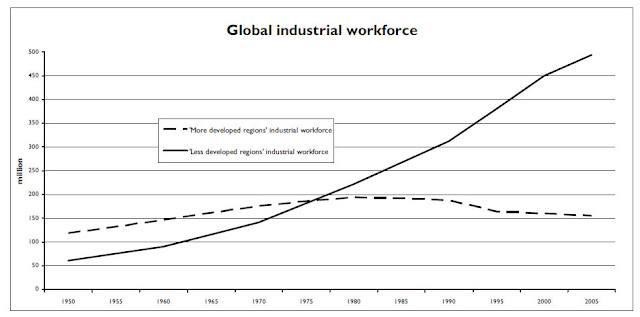 In order to get the complete picture, it is necessary to maintain a global view of the process / Image: Economics of Imperialism
In order to get the complete picture, it is necessary to maintain a global view of the process / Image: Economics of Imperialism
Ignoring these glaring facts, the aforementioned postmodernist authors, Pakulski and Waters, state that, “…the members of a class have to be aware of their commonality and employ some recognized terms for collective self-description. A sense of difference between ‘them’ and ‘us’ is a necessary condition for the formation of class actors that marks the most developed examples of class articulation.”
This would seem to imply that if people don’t see the “them and us”, if millions of workers do not perceive themselves as belonging to a distinct class, then the class does not exist. But it is self-evident that how one perceives oneself is not necessarily what one is in terms of the class one belongs to. A very well-paid worker, who gets a high wage, may consider him or herself to be ‘middle class’, but that doesn’t change the fact that they are wage workers. And when the crisis of capitalism suddenly presents them with the prospect that their jobs are on the line, they can be suddenly awakened to their actual class position.
Global working class has massively increased
In order to get the complete picture, it is necessary to maintain a global view of the process. The capitalist system is a world system, and capitalists move their investment around the world, seeking to maximise their profits. Therefore, the closure of industrial plants in a country like Britain does not necessarily mean a weakening of the working class on a global scale.
The reduction in numbers of the industrial workers in the advanced capitalist countries does not at all imply a contraction of the working class as a whole. On the contrary, these roles will have been replaced by other forms of wage labour in other sectors in the advanced capitalist countries, and new workers will be brought into production as production plants are opened in countries where wages are lower.
If we turn our gaze away from the advanced capitalist countries, and look at the wider picture on a world scale, we see a very different situation to that depicted by our postmodern academics. In the same period, in the formerly ‘less-developed world’, the number of industrial workers has increased from around 190 million to 500 million. That is an increase of over 300 million (see graph). We see then that while a degree of deindustrialisation has taken place in the advanced capitalist countries, a huge degree of industrialisation has taken place on a global scale.
The figures we have for China, for example, show that the industrial workforce there is over 100 million strong. After a period which saw declining numbers of industrial workers in the late 1990s due to the closure of plants in the so-called ‘rust belt’, i.e. some of the old state-owned industries, the numbers started to rise again as of 2000, reaching around 110 million by 2005. China’s manufacturing sector now contributes more to global manufacturing than the United States (see Global manufacturing scorecard: How the US compares to 18 other nations).
In India, the number of manufacturing workers is calculated at being around the 55 million mark. (See Employment Growth in India’s Organized Manufacturing in the Post-GFC period). In fact, India’s manufacturing sector in absolute terms is equal to that of France and Italy, and greater than that of Britain.
Just to list a few more examples: in Brazil, the number of workers in manufacturing is over 8 million; in Vietnam around 12 million; in Mexico around 10 million.
All this means that the industrial working class globally has never been as strong as it is today. In fact, the latest figures show that the number of industrial workers globally has now reached over 700 million in total – a powerful force indeed. At the end of the day the quality of one’s life is determined by access to food, housing, clothing, transport, etc. This is all produced by these millions of workers, and there is no amount of postmodernist jiggery-pokery that can wish this class out of existence.
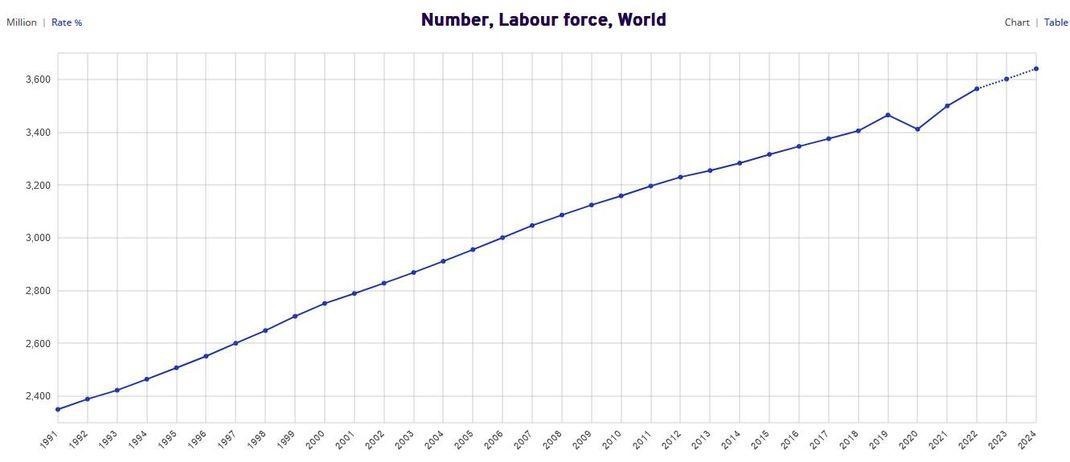 It is abundantly clear that, not only does the working class exist, but it is the overwhelming majority of the world population / Image: International Labour Organization
It is abundantly clear that, not only does the working class exist, but it is the overwhelming majority of the world population / Image: International Labour Organization
As we have shown above, the working class does not merely consist of industrial workers, and there are many other sectors that make up the working class, such as construction, transportation, and so on.
If we look at the overall global workforce by sector, not just those working in industry, we have the following figures: the number working in services is 1.65 billion, in agriculture 873 million, and in industry 758 million. In 1991, the total global workforce was 2.35 billion. This year it is expected to reach around 3.6 billion, according to the International Labour Organisation.
When we consider that 25 percent of the world population is under 15 years of age, and 10 percent is over 65, that leaves roughly 5 billion people of working age. Whichever way you look at it, if you add the children of workers, their non-working partners, and their retired parents, it is abundantly clear that, not only does the working class exist, but it is the overwhelming majority of the world population.
These are the gravediggers of capitalism, as Marx explained. The defeats of the class struggle of the 1970s allowed the capitalist class to achieve a new equilibrium, a temporary stabilisation of the system. It allowed them to go on the offensive against the working class everywhere, taking back rights they had conceded in the previous period, smashing trade unions in many cases, increasing the workload, and extracting greater amounts of surplus value out of the workforce.
Part of this process also involved shifting investments to areas of the world where they could find cheaper labour. This was used also as a lever against the organised workers in the advanced capitalist countries, and this was a period of retreat for the working class. But the flipside of this process was that globally, the working class as a whole was massively numerically strengthened. Objectively speaking, the balance of class forces has therefore never been more favourable than it is today for the working class.
This is the real situation. The people who made the shoes I wear, the table I sit at, and the food I eat do, in fact, exist. However, the role of capitalist propaganda – spread through the mass media, through schools and colleges, through books and articles – is to make the mass of the working people believe they are weak and isolated, and therefore that they do not have the power to change society.
They are aided in this task by the leaders of the trade unions, of the Labour Party in Britain, and all the other so-called ‘leaders’ of the working class internationally, who constantly sell out workers’ struggles and work to undermine the confidence of the working class.
The people at the top, the capitalist class and their serious strategists, are, however, fully conscious of how big the working class really is, and they fear for their own future should this class become conscious of its own strength.
The world economic crisis we have entered is unprecedented in both scope and depth. Its effects are beginning to be felt in mass movements, such as the more recent events in France and Britain with big strike waves; or the insurrectionary movements in Peru or Sri Lanka. In country after country, we have seen the potential for the revolutionary overthrow of the present system.
Life teaches, and the working class is slowly waking up to how serious this crisis is. This will set in motion the powerful force that the global working class has become. With a revolutionary leadership it could snuff out capitalism like a man swatting a fly. The task of the Marxists is to build that leadership.

